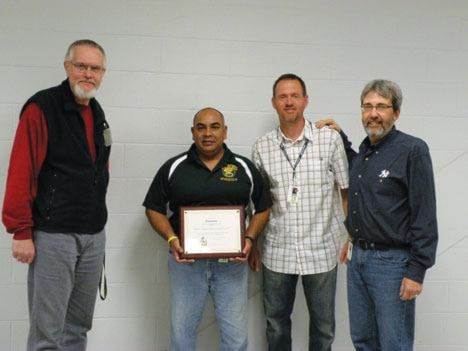The untidy, dusty and, for a long time, noisy atmosphere may have well been hiding it, but it has been taking place firmly, steadily, and almost stealthily.
It is a quiet revolution that has been going on for about a year in the fresh paint smelling classrooms and difficult-to-walk- through corridors of the Wm. E Hay high school, a revolution that has put Stettler’s name on the North American map of high school education as the community of the only Canadian school to win the prestigious “Panasonic National School Change Award.”
Wm. E Hay Composite High School has been slowly but surely taking steps to set the standards for shaping the learning philosophy for the 21st century, at least in a provincial context.
As one of the 24 finalist schools that were invited to New York last July for the National Principals Leadership Institue’s Panasonic National School Change Awards competition, Wm. E Hay Composite High School was recognized for the way it has introduced changes to the education programs that are aimed at giving more freedom and responsibility to students on what they want to learn as well as how and when.
“After our school was recognized as one of the six award winners, lots of people started to come to us and asked us what we were doing in our schools and what we did to get recognized,” said principal Norbert Baharally, reflecting on his impressions at the July 10-13 conference in New York.
“Basically what we are doing is not necessarily trying to improve result scores, or trying to get a higher level at the provincial achievement tests or diploma exam results,” he said.
“It is basically instilling a philosophy that has been in elementary education for years: We are trying to get kids attached to at least one person in the building so that the whole building and its atmosphere become more personal.”
Put in other words, the current application of the learning processes at the Wm. E. Hay is trying ensure that when they get up in the morning, kids will be thinking of the school and they will want to get there as fast as they can.
“The idea is to create an environment that the kids feel a connection to,” said Warren Aspenes, who traveled to New York with principal Baharally to introduce the program they have been implementing.
“Like anything else, motivation, the drive to succeed, for anybody, depends on how well you feel connected to the relationship you are in.”
“And school is all about relationships, students with students, students with teachers, students with administrators, administrators with teachers, and teachers with teachers.”
Aspenes also made a strong point of why they felt they needed to create a home-like warm environment for achieving the ultimate goal in any educational process, a successful learning curve.
“Students who have all the support in the world from home will always succeed, in spite of us. But there is definitely a population of students that don’t have that support and for whatever reason they don’t connect.”
The goal is to have all the students feel themselves connected to school, through their relationships either to a classmate, to a teacher or to a staff member.
As part of this new philosophy of teaching/learning, Aspenes is currently conducting a new “self-directed” program, described by principal Baharally as “more like a university lecturer style course,” whereby the students do not have to sit in the class for a certain period of time. Instead, they look through the information put together by the teacher for the students, meant to function as a guide to lead them to identify how they would like to focus their learning effort and decide how much or how little they will be doing to deserve their credit. In the meantime, the group comes together with the teacher for a seminar-like session each week in addition to a one-on-one half-hour meeting with the teacher.
“That’s a different learning environment and not all the kids are suited to that style of learning. But there are certain kids who will benefit from that and if they can benefit, why shouldn’t we able to give them the opportunity to learn that way?” asked Baharally.
“The freedom and the opportunity to do things differently means actually to be able to try new things and to correct them, adjust them or make them better along the way if they are not working properly. This is big, it means this is an opportunity,” said Baharally.
“It means after the final report is written on this project, maybe the high school education in the entire province may be designed this way. And if it is, this school and this community will be ahead of everybody else.”
This is the first of a two- part series on the flexible education program being implemented at the Wm.E Hay high school.
